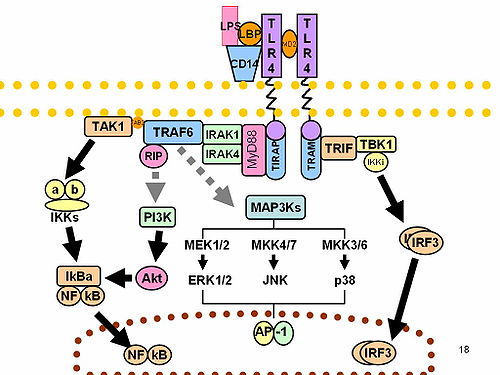RESEARCH HAS BEEN DONE! AND SEE IT THROUGH!
==================================================================
Testosterone and DHT treatment of murine 3T3-L1 or human SGBS adipocytes for 24 h significantly decreased the mRNA expression of LKB1 via the androgen receptor and consequently reduced the activation of AMPK by phosphorylation. In contrast, 17β-estradiol treatment increased LKB1 mRNA, an effect mediated by oestrogen receptor alpha.[2]
However in ER-positive breast cancer cell line MCF-7, estradiol caused a dose-dependent decrease in LKB1 transcript and protein expression leading to a significant decrease in the phosphorylation of the LKB1 target AMPK. ERα binds to the STK11 promoter in a ligand-independent manner and this interaction is decreased in the presence of estradiol. Moreover, STK11 promoter activity is significantly decreased in the presence of estradiol.[3]WIKIPEDIA
=========================================================================================
ganetespib
A synthetic small-molecule inhibitor of heat shock protein 90 (Hsp90) with potential antineoplastic activity. Ganetespib binds to and inhibits Hsp90, resulting in the proteasomal degradation of oncogenic client proteins, the inhibition of cell proliferation and the elevation of heat shock protein 72 (Hsp72); it may inhibit the activity of multiple kinases, such as c-Kit, EGFR, and Bcr-Abl, which as client proteins depend on functional HsP90 for maintenance. Hsp90, a 90 kDa molecular chaperone upregulated in a variety of tumor cells, plays a key role in the conformational maturation, stability and function of "client" proteins within the cell, many of which are involved in signal transduction, cell cycle regulation and apoptosis, including kinases, transcription factors and hormone receptors. Hsp72 exhibits anti-apoptotic functions; its up-regulation may be used as a surrogate marker for Hsp90 inhibition. Check for active clinical trials or closed clinical trials using this agent. (NCI Thesaurus)
SOCINSKI "Purpose: Ganetespib is a novel inhibitor of the heat shock protein 90 (Hsp90), a chaperone protein critical to tumor growth and proliferation. In this phase II study, we evaluated the activity and tolerability of ganetespib in previously treated patients with non–small cell lung cancer (NSCLC)."Patients were enrolled into cohort A (mutant EGFR), B (mutant KRAS), or C (no EGFR or KRAS mutations). Patients were treated with 200 mg/m2 ganetespib by intravenous infusion once weekly for 3 weeks followed by 1 week of rest, until disease progression. The primary endpoint was progression-free survival (PFS) at 16 weeks. Secondary endpoints included objective response (ORR), duration of treatment, tolerability, median PFS, overall survival (OS), and correlative studies.
Results: Ninety-nine patients with a median of 2 prior systemic therapies were enrolled; 98 were assigned to cohort A (n = 15), B (n = 17), or C (n = 66), with PFS rates at 16 weeks of 13.3%, 5.9%, and 19.7%, respectively. Four patients (4%) achieved partial response (PR);
all had disease that harbored anaplastic lymphoma kinase (ALK) gene rearrangement, retrospectively detected by FISH (n = 1) or PCR-based assays (n
= 3), in crizotinib-naïve patients enrolled to cohort C. Eight patients
(8.1%) experienced treatment-related serious adverse
events (AE); 2 of these (cardiac arrest and renal
failure) resulted in death. The most common AEs were diarrhea, fatigue,
nausea, and anorexia.
Conclusions: Ganetespib monotherapy showed a manageable side effect profile as well as clinical activity in heavily pretreated patients
with advanced NSCLCs, particularly in patients with tumors harboring ALK gene rearrangement. Clin Cancer Res; 19(11); 3068–77. ©2013 AACR.
====================================================================
============================================================
SMARCA4 has been shown to interact with Beta-catenin,[7] SIN3A,[8][9] Myc,[10][11] CBX5,[12] SMARCE1,[13][14] HSP90B1,[15] STAT2,[16] CREB-binding protein,[17][18] Glucocorticoid receptor,[19][20] FANCA,[15][21] STK11,[22] BRCA1,[23][24] ACTL6A,[13][14] POLR2A,[8][13][14] ING1,[9] Cyclin E1,[25][26] P53,[27] Estrogen receptor alpha,[17][28] Prohibitin,[29] SMARCC2,[13][14][15] SMARCC1,[8][13][14][15] SMARCB1,[8][13][14][15][30] ARID1B[31][32] and ARID1A.[13][14]
The protein encoded by this gene is a member of the SWI/SNF family of proteins and is similar to the brahma protein of Drosophila. Members of this family have helicase and ATPase activities and are thought to regulate transcription of certain genes by altering the chromatin structure around those genes. The encoded protein is part of the large ATP-dependent chromatin remodeling complex SWI/SNF, which is required for transcriptional activation of genes normally repressed by chromatin. In addition, this protein can bind BRCA1, as well as regulate the expression of the tumorigenic protein CD44.[2]
BRG1 works to activate or repress transcription. Having functional BRG1 is important for development past the pre-implantation stage. Without having a functional BRG1, exhibited with knockout research, the embryo will not hatch out of the zona pellucida which will inhibit implantation from occurring on the endometrium (uterine wall). BRG1 is also crucial to the development of sperm. During the first stages of meiosis in spermatogenesis there are high levels of BRG1. When BRG1 is genetically damaged, meiosis is stopped in prophase 1, hindering the development of sperm and would result in infertility. More knockout research has concluded BRG1’s aid in the development of smooth muscle. In a BRG1 knockout, smooth muscle in the gastrointestinal tract lacks contractility, and intestines are incomplete in some cases. Another defect occurring in knocking out BRG1 in smooth muscle development is heart complications such as an open ductus arteriosus after birth.[3][4]
=====================================================================
Heat shock protein 90kDa alpha (cytosolic), member A1 has been shown to interact with TGF beta receptor 2,[3] FKBP5,[4] TGF beta receptor 1,[3] Glucocorticoid receptor,[5][6][7][8][9][10][11] AKT1,[12][13][14] Hop,[15][16] Peroxisome proliferator-activated receptor alpha,[17] AHSA1,[18] HSF1,[19][20] STK11,[21] C-Raf,[22][23] ERN1,[24] PIM1,[25] GNA12,[26] Endothelial NOS,[27][28][29] Androgen receptor,[30][31] CDC37,[32][33] DAP3,[6] SMYD3,[34] Telomerase reverse transcriptase,[12][13] HER2/neu,[35][36] EPRS,[37] P53,[38][39][40] Estrogen receptor alpha[20][41] and GUCY1B3.[27]

No comments:
Post a Comment